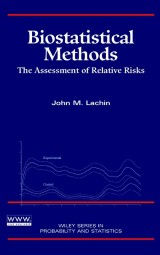Details

Biostatistical Methods
The Assessment of Relative RisksWiley Series in Probability and Statistics, Band 509 1. Aufl.
|
115,99 € |
|
| Verlag: | Wiley |
| Format: | |
| Veröffentl.: | 25.09.2009 |
| ISBN/EAN: | 9780470317891 |
| Sprache: | englisch |
| Anzahl Seiten: | 568 |
DRM-geschütztes eBook, Sie benötigen z.B. Adobe Digital Editions und eine Adobe ID zum Lesen.
Beschreibungen
Comprehensive coverage of classical and modern methods of biostatistics<br> <br> Biostatistical Methods focuses on the assessment of risks and relative risks on the basis of clinical investigations. It develops basic concepts and derives biostatistical methods through both the application of classical mathematical statistical tools and more modern likelihood-based theories.<br> <br> The first half of the book presents methods for the analysis of single and multiple 2x2 tables for cross-sectional, prospective, and retrospective (case-control) sampling, with and without matching using fixed and two-stage random effects models. The text then moves on to present a more modern likelihood- or model-based approach, which includes unconditional and conditional logistic regression; the analysis of count data and the Poisson regression model; and the analysis of event time data, including the proportional hazards and multiplicative intensity models. The book contains a technical appendix that presents the core mathematical statistical theory used for the development of classical and modern statistical methods. Biostatistical Methods: The Assessment of Relative Risks:<br> * Presents modern biostatistical methods that are generalizations of the classical methods discussed<br> * Emphasizes derivations, not just cookbook methods<br> * Provides copious reference citations for further reading<br> * Includes extensive problem sets<br> * Employs case studies to illustrate application of methods<br> * Illustrates all methods using the Statistical Analysis System(r) (SAS)<br> <br> Supplemented with numerous graphs, charts, and tables as well as a Web site for larger data sets and exercises, Biostatistical Methods: The Assessment of Relative Risks is an excellent guide for graduate-level students in biostatistics and an invaluable reference for biostatisticians, applied statisticians, and epidemiologists.
Biostatistics and Biomedical Science.<br> <br> Relative Risk Estimates and Tests for Two Independent Groups.<br> <br> Sample Size, Power, and Efficiency.<br> <br> Stratified-Adjusted Analysis for Two Independent Groups.<br> <br> Case-Control and Matched Studies.<br> <br> Applications of Maximum Likelihood and Efficient Scores.<br> <br> Logistic Regression Models.<br> <br> Analysis of Count Data.<br> <br> Analysis of Event-Time Data.<br> <br> Appendices.<br> <br> References.<br> <br> Indexes.
This is an excellent textbook for an advanced course in biostatsitics and also an indispensable reference for biostatisticians and epidemiologists...what makes this textbook so valuable is that it covers the core methods first using classical statistical tools and then likelihood-based theories, highlighting the continuities. Another important feature is the care and balance with which it is drafted: the reasoning is always clear, the mathematical presentation detailed but to thepoint, the examples linked across different chapters. (Short Book Reviews, Vol. 20, No. 3, December 2000)<br> <br> "...an excellent guide for graduate-level students in biostatistics and invaluable reference for biostatisticians, applied statisticians, and epidemiologists." (Mathematical Reviews, Issue 2001h)<br> <br> "...does a very thorough job of establishing a sound bias for the use of biostatistical methodology." (Technometrics, February 2002)<br> <br> "..an excellent guide for graduate-level students in biostatistics and an invaluable reference for biostatisticians, applied statisticians, and epidemiologists." (Zentralblatt MATH, Vol. 961, 2001/11)<br> <br> "the book is an excellent guide" (Zentralblatt MATH, Vol.961, No.11 2001)
JOHN M. LACHIN, ScD, is Professor of Statistics and Biostatistics at the George Washington University in Washington, D.C., and Director of the Biostatistics Center in Rockville, Maryland.
Comprehensive coverage of classical and modern methods of biostatistics<br> <br> Biostatistical Methods focuses on the assessment of risks and relative risks on the basis of clinical investigations. It develops basic concepts and derives biostatistical methods through both the application of classical mathematical statistical tools and more modern likelihood-based theories.<br> <br> The first half of the book presents methods for the analysis of single and multiple 2x2 tables for cross-sectional, prospective, and retrospective (case-control) sampling, with and without matching using fixed and two-stage random effects models. The text then moves on to present a more modern likelihood- or model-based approach, which includes unconditional and conditional logistic regression; the analysis of count data and the Poisson regression model; and the analysis of event time data, including the proportional hazards and multiplicative intensity models. The book contains a technical appendix that presents the core mathematical statistical theory used for the development of classical and modern statistical methods. Biostatistical Methods: The Assessment of Relative Risks:<br> * Presents modern biostatistical methods that are generalizations of the classical methods discussed<br> * Emphasizes derivations, not just cookbook methods<br> * Provides copious reference citations for further reading<br> * Includes extensive problem sets<br> * Employs case studies to illustrate application of methods<br> * Illustrates all methods using the Statistical Analysis System(r) (SAS)<br> <br> Supplemented with numerous graphs, charts, and tables as well as a Web site for larger data sets and exercises, Biostatistical Methods: The Assessment of Relative Risks is an excellent guide for graduate-level students in biostatistics and an invaluable reference for biostatisticians, applied statisticians, and epidemiologists.
Diese Produkte könnten Sie auch interessieren:

Nonparametric Regression Methods for Longitudinal Data Analysis

von: Hulin Wu, Jin-Ting Zhang

135,99 €

Statistics and the Evaluation of Evidence for Forensic Scientists

von: Colin Aitken, Franco Taroni

103,99 €














